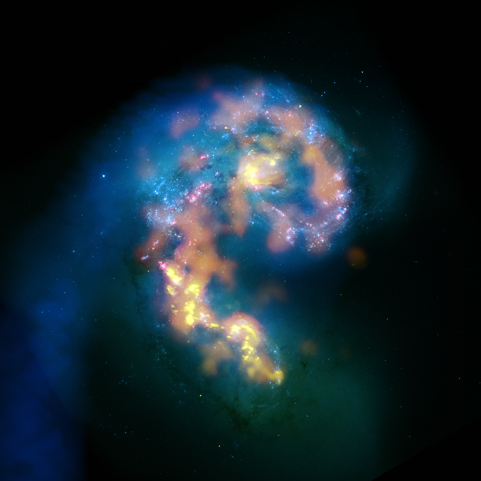October 3, 2011
Contact:
Tania Burchell, ALMA Public Information Officer
Charlottesville, VA
(434) 244-6812
tburchel@nrao.edu
First Images from ALMA
The detailed views of star-formation in the Antennae Galaxies are the first astronomical test images released to the public from the growing Atacama Large Millimeter/submillimeter Array (ALMA) and confirm that this new telescope has surpassed all others of its kind.

Multiwavelength composite of interacting galaxies NGC 4038/4039, the Antennae, showing VLA radio (blues), past and recent starbirths in HST and CTIO optical (whites and pinks), and a selection of current star-forming regions in ALMA's mm/submm (orange and yellows) showing detail surpassing all other views in these wavelengths.
|
|
|
Image Use Policy |
|
In celebration of the start of the Atacama Large Millimeter/submillimeter Array's (ALMA) Early Science observations, the National Radio Astronomy Observatory (NRAO) has released an image of a merging pair of galaxies as seen by the growing ALMA telescope. The detailed views of star-formation in the Antennae Galaxies confirm that this new telescope, while far from completed, and with only a fraction of its ultimate imaging capability, will surpass all others of its kind.
The image gives but a hint of ALMA's promise to make unprecedented contributions to understanding the once-hidden activities of the early Universe.
The Observations "We chose the impressive interacting system called the Antennae galaxies as a test subject," said Dr. Alison Peck, an astronomer from the NRAO who is serving in Chile as ALMA Deputy Project Scientist during its years of careful construction and rigorous testing, "because it is in the process of undergoing the type of spectacular, violent merger that many galaxies may have undergone since their formation, but that we can rarely catch in action."
This image is a composite of views of the Antennae taken with several different types of telescopes, including test data from ALMA (orange and yellow, and shown alone in the inset). Like the view from an ultrasound of an expectant mother's womb, ALMA reveals hidden starbirth nestled inside otherwise obscuring dust clouds.
"ALMA's test views of the Antennae show us star-forming regions on a level of detail that no other telescope on Earth or in space has attained. This capability can only get much better as ALMA nears completion," said Dr. Mark McKinnon, North American ALMA Project Manager from the NRAO in Charlottesville, Virginia.
The inset boxes show regions imaged in additional, higher detail. With this weekend's start of ALMA's first official cycle of observing, called Early Science, a team of North American astronomers is poised to make even more detailed observations of the Antennae.
"The collision of these two galaxies has turned them into an impressive star-making factory. With Hubble, we've seen the formation of thousands of massive super star clusters, each with thousands or even millions of young stars in them," said team leader, Dr. Brad Whitmore of the Space Telescope Science Institute. "With ALMA, we will focus on the heart of the collision, the interaction region where the two galaxies are crashing together. We can then study the formation of the Antennae's most impressive fireworks and look into the cores of the giant molecular clouds where the star clusters are born."
By 2013, ALMA will have more than tripled its current number of telescopes to 66. With the telescopes combined into a single system by one of the world's fastest, special-purpose supercomputers, and aimed at many more objects all across the sky, ALMA will reveal a Universe never before seen.
The Antennae Galaxies
About six hundred million years ago, this peculiar object was two separate, beautiful spiral galaxies passing by each other for the first time. Now, it captivates astronomers as the youngest and nearest colliding galaxy pair ever found.
Spiral galaxies are a spectacular example of gravity's beautiful geometries, stunning structures created when swirling gas and dust are drawn together. In a spiral galaxy's center, a central massive black hole hoards a giant glowing bulge of gas and stars for itself, while out in the spinning disk, rippling compression waves trigger stars to form along its dusty, gas-rich arms. In isolation, a spiral galaxy would make stars like this until its gas was too thinly spread to fuel any new ones.
In contrast, colliding galaxies like the Antennae are an equally spectacular example of gravity's jumbled catastrophes. If two spirals form too near each other, their centers will slowly tug each other closer, and the gas and stars from their outer disks will lag behind, eventually trailing off into tails. As the central denser parts of the galaxies slowly collide over millions of years, their gas and dust clouds often compress together, eventually producing clumps of new stars.
For guided video tours of ALMA, please enjoy our ALMA Explorer.
The National Radio Astronomy Observatory is a facility of the National Science Foundation, operated under cooperative agreement by Associated Universities, Inc.
The Atacama Large Millimeter/submillimeter Array (ALMA), an international astronomy facility, is a partnership between Europe, Japan and North America in cooperation with the Republic of Chile. ALMA is funded in Europe by the European Southern Observatory (ESO), in Japan by the National Institutes of Natural Sciences (NINS) in cooperation with the Academia Sinica in Taiwan and in North America by the U.S. National Science Foundation (NSF) in cooperation with the National Research Council of Canada (NRC) and the National Science Council of Taiwan (NSC). ALMA construction and operations are led on behalf of Europe by ESO, on behalf of Japan by the National Astronomical Observatory of Japan (NAOJ) and on behalf of North America by the National Radio Astronomy Observatory (NRAO), which is managed by Associated Universities, Inc. (AUI).
